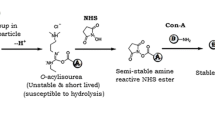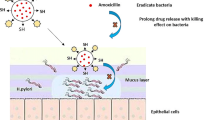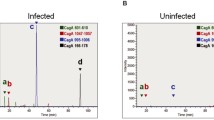Abstract
The first step in the development of Helicobacter pylori pathogenicity is the receptor-mediated adhesion to the gastric epithelium. Inhibition of outer membrane proteins of H. pylori (e.g. BabA) by antiadhesive drugs will contribute to reduced recolonization and infection. Pectin from apple inhibits the BabA and LPS-mediated adhesion of H. pylori to human stomach cells. Pectin-coated liposomes with encapsulated amoxicillin were characterized for polydispersity, zeta potential, encapsulation efficiency, stability, and amoxicillin release. Coated liposomes did not influence the viability of AGS and HT29-MTX cells up to 100 μg/mL but exert cytotoxicity against H. pylori at 10 μg/mL. Pectin-coating of liposomes provoked direct interaction and subsequent binding of the particles to surface structures of H. pylori, and interaction with mucus from porcine stomach and mucus secreted by HT29-MTX cells. Laser scanning microscopy of H. pylori and AGS cells together with liposomes indicated co-aggregation. The mucoadhesive effect seems interesting as stomach cells are covered by a mucus layer. H. pylori is able to penetrate and cross the mucin rapidly to reach pH-neutral epithelium to escape the acidic environment, followed by interaction with epithelial cells. In summary, all experimental evidence is consistent with a specific interaction of pectin-coated liposomes with mucins and surface structures of H. pylori. As the coated liposomes show mucoadhesion to the negatively charged mucins, docking to stomach mucin, mucus penetration, and recognition of and adhesion to H. pylori, they can be considered a novel type of multifunctional drug carriers for local antibiotic therapy against H. pylori.
Key points
• Smart, multifunctional mucoadhesive liposomes
• Specific targeting against BabA/LPS of Helicobacter pylori
• Inhibition of bacterial adhesion of H. pylori to human host cells
• Release of antibiotic cargo









Similar content being viewed by others
References
Adamczak MI, Martinsen ØG, Smistad G, Hiorth M (2016) Water sorption properties of HM-pectin and liposomes intended to alleviate dry mouth. Inter J Pharm 506:201–206
Algood HMS, Cover TL (2006) Helicobacter pylori persistence: an overview of interactions between H. pylori and host immune defenses. Clin Microbiol Rev 19:597–613
Angsantikul P, Thamphiwatana S, Zhang Q, Spiekermann K, Zhuang J, Fang RH, Gao W, Obonyo M, Zhang L (2018) Coating nanoparticles with gastric epithelial cell membrane for targeted antibiotic delivery against Helicobacter pylori infection. Adv Ther 1:1800016
Ansari S, Yamaoka Y (2019) Helicobacter pylori virulence factors exploiting gastric colonization and its pathogenicity. Toxins 11:677
Bardonnet P-L, Faivre V, Boullanger P, Piffaretti J-C, Falson F (2008) Pre-formulation of liposomes against Helicobacter pylori: characterization and interaction with the bacteria. Eur J Pharm Biopharm 69:908–922
Cao X, Bansil R, Bhaskar KR, Turner BS, LaMont JT, Niu N, Afdhal NH (1999) pH-Dependent conformational change of gastric mucin leads to sol-gel transition. Biophys J 76:1250–1258
Cho JH, Kwun YS, Jang HS, Kang JM, Won YS, Yoon HR (2000) Long-term use of preservatives on rat nasal respiratory mucosa: effects of benzalkonium chloride and potassium sorbate. Laryngoscope 110:312–317
Cornick S, Tawiah A, Chadee K (2015) Roles and regulation of the mucus barrier in the gut. Tissue Barriers 3:e982426
Danaei M, Dehghankhold M, Ataei S, Hasanzadeh Davarani F, Javanmard R, Dokhani A, Khorasani S, Mozafari MR (2018) Impact of particle size and polydispersity index on the clinical applications of lipidic nanocarrier systems. Pharmaceutics 10.
Dragicevic-Curic N, Scheglmann D, Albrecht V, Fahr A (2008) Temoporfin-loaded invasomes: development, characterization and in vitro skin penetration studies. J Contr Rel 127:59–69
Fredenberg S, Wahlgren M, Reslow M, Axelsson A (2011) The mechanisms of drug release in poly(lactic-co-glycolic acid)-based drug delivery systems-a review. Inter J Pharm 415:34–52
Gottesmann M, Paraskevopoulou V, Mohammed A, Falcone FH, Hensel A (2020) BabA and LPS inhibitors against Helicobacter pylori: pectins and pectin-like rhamnogalacturonans as adhesion blockers. Appl Microbiol Biotechnol 104:351–363
Goycoolea FM, Morris ER, Gidley MJ (1995) Screening for synergistic interactions in dilute polysaccharide solutions. Carbohydr Polymers 28:351–358
Guyer W, Bloch K (1983) Phosphatidylcholine and cholesterol interactions in model membranes. Chem Phys Lipids 33:313–322
Hage N, Howard T, Phillips C, Brassington C, Overman R, Debreczni J, Gellert P, Stolnik S, Winkler GS, Falcone FH (2015) Structural basis of Lewis(b) antigen binding by the Helicobacter pylori adhesin BabA. Science Advances 1:e1500315–e1500315
Hassan EE, Gallo JM (1990) A simple rheological method for the in vitro assessment of mucin-polymer bioadhesive bond strength. Pharm. Res 7:491–495
Helicobacter and Cancer Collaborative Group (2001) Gastric cancer and Helicobacter pylori: a combined analysis of 12 case control studies nested within prospective cohorts. Gut 49:347–353
Hensel A, Deters AM, Müller G, Stark T, Wittschier N, Hofmann T (2007) Occurrence of N-phenylpropenoyl-L-amino acid amides in different herbal drugs and their influence on human keratinocytes, on human liver cells and on adhesion of Helicobacter pylori to the human stomach. Planta Med 73:142–150
Herrmann A, König S, Lechtenberg M, Sehlbach M, Vakhrushev SY, Peter-Katalinic J, Hensel A (2012) Proteoglycans from Boswellia serrata Roxb. and B. carteri Birdw. and identification of a proteolytic plant basic secretory protein. Glycobiology 22:1424–1439
International Agency for Research on Cancer IARC Working Group on the Evaluation of Carcinogenic Risks to Humans (1994) Schistosomes, liver flukes and Helicobacter pylori. Lyon, France, International Agency for Research on Cancer. IARC Monographs on the Evaluation of Carcinogenic Risks to Humans, 61.
Lesuffleur T, Porchet N, Aubert JP, Swallow D, Gum JR, Kim YS, Real FX, Zweibaum A (1993) Differential expression of the human mucin genes MUC1 to MUC5 in relation to growth and differentiation of different mucus-secreting HT-29 cell subpopulations. J Cell Sci 106(Pt 3):771–783
Lin Y-H, Tsai S-C, Lai C-H, Lee C-H, He ZS, Tseng G-C (2013) Genipin-cross-linked fucose-chitosan/heparin nanoparticles for the eradication of Helicobacter pylori. Biomaterials 34:4466–4479
Malfertheiner P, Megraud F, O'Morain CA, Gisbert JP, Kuipers EJ, Axon AT, Bazzoli F, Gasbarrini A, Atherton J, Graham DY, Hunt R, Moayyedi P, Rokkas T, Rugge M, Selgrad M, Suerbaum S, Sugano K, El-Omar EM (2017) Management of Helicobacter pylori infection – the Maastricht V/Florence Consensus Report. Gut. 66:6–30
Menchicchi B, Fuenzalida JP, Bobbili KB, Hensel A, Swamy MJ, Goycoolea FM (2014) Structure of chitosan determines its interactions with mucin. Biomacromolecules 15:3550–3558
Menchicchi B, Fuenzalida JP, Hensel A, Swamy MJ, David L, Rochas C, Goycoolea FM (2015a) Biophysical analysis of the molecular interactions between polysaccharides and mucin. Biomacromolecules 16:924–935
Menchicchi B, Hensel A, Goycoolea FM (2015b) Polysaccharides as bacterial antiadhesive agents and “smart” constituents for improved drug delivery systems against Helicobacter pylori infection. Cur Pharm Des 21:4888–4906
Menchicchi B, Savvaidou E, Thöle C, Hensel A, Goycoolea FM (2019) Low-molecular-weight dextran sulfate nanocapsules inhibit the adhesion of Helicobacter pylori to gastric cells. ACS Appl. Bio Mater. 2:4777–4789
Messing J, Niehues M, Shevtsova A, Borén T, Hensel A (2014) Antiadhesive properties of arabinogalactan protein from Ribes nigrum seeds against bacterial adhesion of Helicobacter pylori. Molecules 19:3696–3717
Mosmann T (1983) Rapid colorimetric assay for cellular growth and survival: Application to proliferation and cytotoxicity assays. J Immunol Meth 65:55–63
Mysore JV, Wigginton T, Simon PM, Zopf D, Heman-Ackah LM, Dubois A (1999) Treatment of Helicobacter pylori infection in rhesus monkeys using a novel antiadhesion compound. Gastroenterology 117:1316–1325
Narożańska E, Białecka M, Adamiak-Giera U, Gawrońska-Szklarz B, Sołtan W, Schinwelski M, Robowski P, Madaliński MH, Sławek J (2014) Pharmacokinetics of levodopa in patients with Parkinson disease and motor fluctuations depending on the presence of Helicobacter pylori infection. Clin Neuropharmacol 37:96–99
Niehues M, Hensel A (2009) In-vitro interaction of L-dopa with bacterial adhesins of Helicobacter pylori: an explanation for clinical differences in bioavailability? J Pharm Pharmacol 61:1303–1307
Niehues M, Euler M, Georgi G, Mank M, Stahl B, Hensel A (2010) Peptides from Pisum sativum L. enzymatic protein digest with anti-adhesive activity against Helicobacter pylori: structure-activity and inhibitory activity against BabA, SabA, HpaA and a fibronectin-binding adhesin. Mol Nutr Food Res 54:1851–1861
Nogueira F, Gonçalves IC, Martins MCL (2013) Effect of gastric environment on Helicobacter pylori adhesion to a mucoadhesive polymer. Acta Biomat 9:5208–5215
Parente F, Cucino C, Anderloni A, Grandinetti G, Porro GB (2003) Treatment of Helicobacter pylori infection using a novel antiadhesion compound (3’sialyllactose sodium salt). A double blind, placebo-controlled clinical study. Helicobacter 8:252–256
Qin X, Engwer C, Desai S, Vila-Sanjurjo C, Goycoolea FM (2017) An investigation of the interactions between an E. coli bacterial quorum sensing biosensor and chitosan-based nanocapsules. Coll Surf B, Biointerfaces 149:358–368
Ramteke S, Ganesh N, Bhattacharya S, Jain NK (2008) Triple therapy-based targeted nanoparticles for the treatment of Helicobacter pylori. J Drug Target 16:694–705
Rowland RN, Woodley JF (1980) The stability of liposomes in vitro to pH, bile salts and pancreatic lipase. Biochim Biophysica Acta Lipids and Lipid Metabolism 620:400–409
Sehlbach M, König S, Mormann M, Sendker J, Hensel A (2013) Arabinogalactan protein cluster from Jatropha curcas seed embryo contains fasciclin, xylogen and LysM proteins. Carbohydr Polymers 98:522–531
Shmuely H, Burger O, Neeman I, Yahav J, Samra Z, Niv Y, Sharon N, Weiss E, Athamna A, Tabak M, Ofek I (2004) Susceptibility of Helicobacter pylori isolates to the antiadhesion activity of a high-molecular-weight constituent of cranberry. Diagn Microbiol Infectious Dis 50:231–235
Sitarz R, Skierucha M, Mielko J, Offerhaus GJA, Maciejewski R, Polkowski WP (2018) Gastric cancer: epidemiology, prevention, classification, and treatment. Cancer Manag Res 10:239–248
Trampenau C, Müller K-D (2003) Affinity of Helicobacter pylori to cholesterol and other steroids. Micr Infect 5:13–17
Waigh TA, Papagiannopoulos A, Voice A, Bansil R, Unwin AP, Dewhurst CD, Turner B, Afdhal N (2002) Entanglement coupling in porcine stomach mucin. Langmuir 18:7188–7195
Weissman G, SESSA G, Weismann S (1965) Effect of steroids and ‘Triton X-100’ on glucose-filled phospholipid/cholesterol structures. Nature 208:649–651
WHO (2017) https://www.who.int/en/news-room/detail/27-02-2017-who-publishes-list-of-bacteria-for-which-new-antibiotics-are-urgently-needed. Last access 25. March 2010.
Wittschier N, Lengsfeld C, Vorthems S, Stratmann U, Ernst JF, Verspohl EJ, Hensel A (2007) Large molecules as anti-adhesive compounds against pathogens. J Pharm Pharmacol 59:777–786
Wittschier N, Faller G, Hensel A (2009) Aqueous extracts and polysaccharides from liquorice roots (Glycyrrhiza glabra L.) inhibit adhesion of Helicobacter pylori to human gastric mucosa. J Ethnopharmacol 125:218–223
Zamani M, Ebrahimtabar F, Zamani V, Miller WH, Alizadeh-Navaci R, Shokri-Shirvani J, Derakhshan MH (2018) Systematic review with meta-analysis: the worldwide prevalence of Helicobacter pylori infection. Aliment Pharmacol Ther 47:868–152
Acknowledgements
The authors thank Prof. Dr. K. Langer, University of Münster, for the HT29-MTX cells and for using Zetasizer.
Funding
The study had been fully financed from intramural grants of the University of Münster (no grant numbers available).
Author information
Authors and Affiliations
Contributions
MG performed experiments and made substantial contributions to acquisition, analysis, and interpretation of data; TS helped with confocal laser scanning microscopy; TM helped during the liposome preparation; FG was involved in experiments and revised and discussed the MS; AH designed the study and has been involved in drafting and revising the MS.
Corresponding author
Ethics declarations
Ethical approval
This article does not contain studies with human participants performed by any of the authors.
Conflict of interest
The authors declare that they have no conflict of interest.
Additional information
Publisher’s note
Springer Nature remains neutral with regard to jurisdictional claims in published maps and institutional affiliations.
Electronic supplementary material
ESM 1
(PDF 618 kb)
Rights and permissions
About this article
Cite this article
Gottesmann, M., Goycoolea, F.M., Steinbacher, T. et al. Smart drug delivery against Helicobacter pylori: pectin-coated, mucoadhesive liposomes with antiadhesive activity and antibiotic cargo. Appl Microbiol Biotechnol 104, 5943–5957 (2020). https://doi.org/10.1007/s00253-020-10647-3
Received:
Revised:
Accepted:
Published:
Issue Date:
DOI: https://doi.org/10.1007/s00253-020-10647-3




